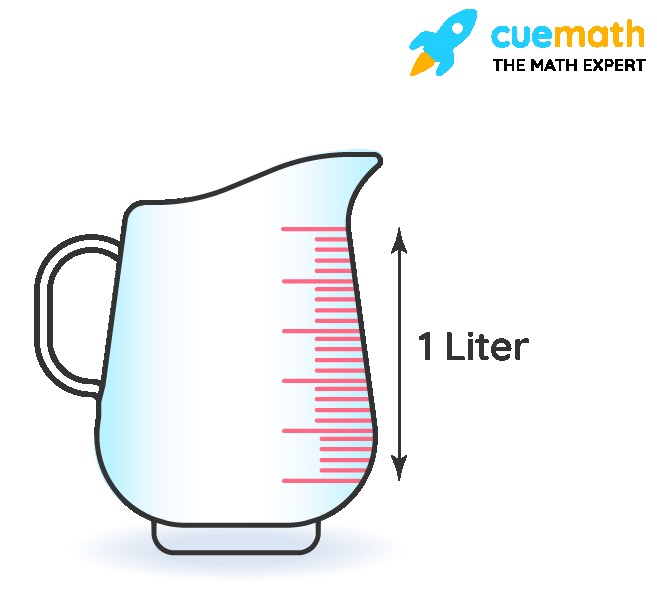Understanding volume is fundamental in everyday life, whether you’re cooking, measuring liquids for experiments, or staying hydrated. Among the common units of volume, liters and milliliters stand out. But how exactly do they relate to each other? If you’ve ever wondered, “How Many Milliliters Are In A Liter?”, you’ve come to the right place. This comprehensive guide will break down the relationship between these metric units, explain the conversion process, and provide practical examples to solidify your understanding.
Delving into the Liter: A Basic Unit of Volume
The liter (L or l) is a fundamental unit of volume within the metric system. It’s widely used for measuring liquids and is defined as the volume of one cubic decimeter (1 L = 1 dm³). To give you a visual, imagine a cube that is 10 centimeters (cm) in length, width, and height – the space it occupies is equal to one liter.
Liters are practical for measuring larger quantities of liquids. Think about purchasing beverages like juice, milk, or soda – they are typically sold in liter or multi-liter containers. The liter provides a convenient scale for these everyday volumes.
Alt text: One-liter pitcher demonstrating liquid volume capacity.
Exploring the Milliliter: Measuring Smaller Volumes
The milliliter (mL or ml) is a smaller unit of volume, also within the metric system. As the prefix “milli” indicates, a milliliter is one-thousandth of a liter. This means that it takes one thousand milliliters to make up a single liter.
Milliliters are ideal for measuring smaller volumes of liquids, such as doses of medicine, ingredients in recipes (especially in baking and precise cooking), or volumes used in scientific experiments where accuracy is paramount. You’ll often see milliliters used on syringes, measuring spoons, and smaller bottles of liquids.
Alt text: Pitcher filled with 1000 milliliters of water, equivalent to one liter.
The Key Conversion Factor: Liters and Milliliters
The relationship between liters and milliliters is straightforward and based on a factor of 1000. The crucial conversion factor to remember is:
1 Liter (L) = 1000 Milliliters (mL)
This simple ratio is the foundation for converting between these two units. Understanding this conversion is essential for accurate measurements and calculations involving volume.
Converting Liters to Milliliters: A Simple Multiplication
To convert a volume from liters to milliliters, you simply multiply the quantity in liters by 1000. This is because each liter contains 1000 milliliters.
Formula: Milliliters (mL) = Liters (L) × 1000
Example: Let’s convert 2.5 liters to milliliters.
Milliliters = 2.5 L × 1000 = 2500 mL
Therefore, 2.5 liters is equal to 2500 milliliters.
Converting Milliliters to Liters: Division is Key
Conversely, to convert from milliliters back to liters, you need to divide the quantity in milliliters by 1000. This reverses the multiplication process and gives you the equivalent volume in liters.
Formula: Liters (L) = Milliliters (mL) ÷ 1000
Example: Let’s convert 500 milliliters to liters.
Liters = 500 mL ÷ 1000 = 0.5 L
Therefore, 500 milliliters is equal to 0.5 liters (or half a liter).
Alt text: Conversion formula diagram illustrating liters to milliliters conversion by multiplying by 1000 and milliliters to liters conversion by dividing by 1000.
Practical Examples: Liters to Milliliters in Action
Let’s explore some real-world examples to solidify your understanding of liter to milliliter conversions:
Example 1: Hydration. If you are advised to drink 2 liters of water per day, how many milliliters is that?
Conversion: 2 L × 1000 = 2000 mL. You should aim to drink 2000 milliliters of water daily.
Example 2: Cooking. A recipe calls for 0.25 liters of milk. How would you measure this in milliliters?
Conversion: 0.25 L × 1000 = 250 mL. You need to measure 250 milliliters of milk.
Example 3: Medicine Dosage. A cough syrup bottle contains 120 mL. How many liters is this?
Conversion: 120 mL ÷ 1000 = 0.12 L. The bottle contains 0.12 liters of cough syrup.
Example 4: Juice for a Party. You’re buying juice for a party and need 5 liters. The juice boxes are in milliliters. How many milliliters of juice do you need in total?
Conversion: 5 L × 1000 = 5000 mL. You need 5000 milliliters of juice.
Common Questions About Liter and Milliliter Conversions
Is 1 liter the same as 1000 ml?
Yes, 1 liter is exactly equal to 1000 milliliters. This is the fundamental relationship between these two units.
How many ml in half a liter?
Half a liter is 0.5 liters. To convert to milliliters: 0.5 L × 1000 = 500 mL. So, there are 500 ml in half a liter.
Is a milliliter the same as a cc?
Yes, in practical terms, a milliliter (mL) and a cubic centimeter (cc) are considered equivalent and are often used interchangeably, especially in medical and scientific fields. 1 mL = 1 cc.
Why use milliliters when we have liters?
Milliliters are used for convenience when measuring smaller volumes. Just like we use centimeters instead of meters for smaller lengths, milliliters provide a more manageable number when dealing with fractions of a liter.
Conclusion: Mastering Volume Conversion
Understanding the conversion between liters and milliliters is a simple yet essential skill. By remembering that 1 liter equals 1000 milliliters, and using multiplication and division accordingly, you can confidently convert between these units in various everyday and scientific situations. Whether you’re in the kitchen, the lab, or simply trying to understand product labels, knowing how to navigate liters and milliliters will prove to be incredibly useful.

